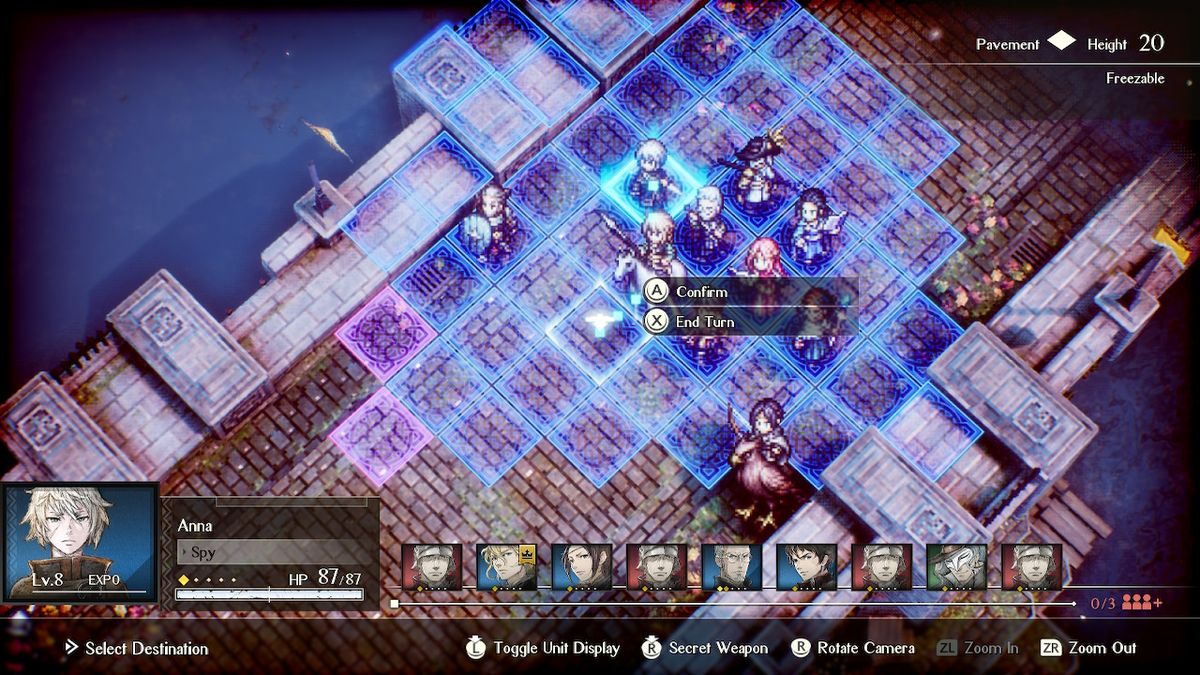Game On: ‘Project Triangle Strategy’ demo shows off an invigorating tactical RPG

On Feb. 17, Nintendo hosted its first full-length “Nintendo Direct” in two years – streamed online, of course – and fans of first-party titles were left largely disappointed. There were no details regarding the next “The Legend of Zelda” game, nor any additional information for “Metroid Prime 4,” which was teased all the way back in June 2017. The best “Mario” fans got was the unveiling of a spinoff title, “Mario Golf Super Rush.”
On the plus side, there were plenty of exciting third-party announcements. “Neon White” looks like a thrilling mobility-based first-person shooter with a heaven vs. hell twist, and I’m all for it. The tough-as-nails “Ninja Gaiden” trilogy is being remastered for the Nintendo Switch – a risky proposition when you juxtapose the frailty of the Switch “joycons” with the controller-throwing rage often induced by those games. I’m kidding – mostly.
Nintendo’s dominion over the Japanese market is evident as ever, but one Japanese role-playing game stood out far above the rest: “Project Triangle Strategy,” a tactical RPG by Square Enix and obvious successor to the massively popular “Final Fantasy Tactics” from 1997.
If you’ve played the likes of “Shining Force,” “Fire Emblem” or “Tactics Ogre,” you should know what to expect, but, for everyone else, tactical RPGs are pretty standard fantasy/sci-fi romps with an important twist.
Battles are turn-based, taking place on a grid with plenty of terrain-based considerations such as the use of cover, height advantage and bottlenecks. Different units can often attack from different angles akin to chess, where knights can “hop” over pieces to gain an advantage. In “Project Triangle Strategy,” the ante has been upped even further by adding directional considerations – characters struck from behind suffer a guaranteed critical hit, for instance.
Like other games of its type, the plot revolves around warring factions and political intrigue. You control a benevolent monarch caught in the middle of betrayal, with only a few friends on your side helping to clear your name and save the kingdom. It’s fairly standard stuff, but the graphical presentation is breathtaking, and the extensive voice acting is top-notch.
Couple that with clever dialogue mechanics allowing players to make democratic decisions with their team, sway the opinions of their allies and have meaningful influence upon the many characters met between battles, and you’ve got yourself a very solid game.
Despite the gorgeous visual design and excellent voiceover, this masterpiece in the making could’ve been slept on if it were poorly unveiled. But Square Enix employed a rather newfound marketing strategy: Announce the game, and tell the public they can download it immediately. “Apex Legends’’ was released completely out of the blue in February 2019, and, despite entering the oversaturated battle-royale market, the game succeeded in carving out its niche.
During Electronic Arts’ Q3 2021 earnings call, CEO Andrew Wilson said the game has a 30% growth in new players year over year. It’s difficult to say with certainty, but if “Apex Legends” had been announced months prior to its launch, as is the industry standard, the hype would’ve been mitigated, and it would’ve fallen flat against its competitors – namely “Fortnite” and “PlayerUnknown’s Battlegrounds.”
In the case of “Project Triangle Strategy,” the immediately accessible download is only a demo, but it’s certainly impressive and lengthy enough to put the game on players’ wish lists. After playing through the nearly five-hour snippet, it’s jumped to the top of my most-anticipated-games list.
My only qualm is its name – “Project Triangle Strategy” might be the worst working title I’ve ever heard, even above the original “Crash Bandicoot” being internally referred to as “Sonic’s Ass Game” during development. I did not make that up.
“Project Triangle Strategy” won’t hit shelves until sometime in 2022, so if you’d like to try your hand at some classic tactical RPGs in the meantime, as a Sega fanboy I can’t recommend the “Shining Force” series quite enough.
Failing that, I can confirm “Final Fantasy Tactics” earned its legendary reputation. Or if you want to get to know the droves of anime swordsmen present in “Super Smash Brothers,” check out any one of the multitudes of “Fire Emblem” games Nintendo has released over the years.
More modern tactical RPGs include “Into the Breach” and “Wargroove.” The former is intriguing for its mech battles and randomly generated gameplay elements. “Wargroove” is a vibrant fantasy game with more than 50 hours of single-player content, as well as extensive creation tools, allowing gamers to create entire scenarios of their own to share with others.
Tactical RPGs are a niche subgenre with plenty to offer the experienced and inexperienced gamer alike: Their slow, methodical pace allows entry-level gamers to have a good time. At the same time, they demand players to stop and think a bit, keeping even seasoned gamers on their toes with each and every move.
I’m glad to see a prominent publisher like Square Enix pulling out all the stops and giving this genre the well-polished shakeup it deserves with “Project Triangle Strategy.” The demo can be downloaded on the Nintendo Switch via the Nintendo eShop.
Riordan Zentler can be reached at riordanzentler@gmail.com.